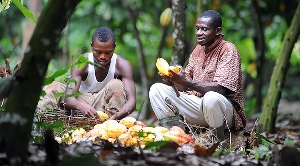On account of tight global supply conditions, cocoa industry analysts are projecting prices could rise to as high as US$9,600 per metric tonne (pmt) in 2025. In fact, this figure was surpassed in December 2024 when it reached US$11,925.
On January 8, 2025, March ICE NY cocoa futures closed at US$10,984.81 per metric tonne – reflecting a 1.68 percent decrease from the previous day.
Meanwhile, in December 2024 the global cocoa price reached US$10.32 per kilogramme – marking a 30.73 percent increase from November 2024 and a 145.2 percent rise from December 2023.
This forecast comes after a dramatic price-surge in 2024, when cocoa prices nearly doubled year-to-date by mid-November; reaching US$8,523 from an initial US$4,916.
The 73.4 percent rise was driven by supply shortfalls in Ghana and Côte d’Ivoire, intensified by El Niño’s impact on yields and growing global demand for chocolate.
According to Databank’s 2025 projections: “The European Union Deforestation Regulation (EUDR), effective in early 2025, will further restrict supply availability; likely keeping prices elevated amid strong global demand for chocolate”.
These notwithstanding, the domestic market has been saddled with funding issues – inefficiency on the part of industry regulator Ghana Cocoa Board (COCOBOD) being cited as a major factor.
Last year, it struggled to raise the annual syndicated loan from its usual partners. These and related reasons have contributed to local farmers failing to benefit from the windfall occasioned by increasing prices.
The impending EUDR introduces stringent requirements for cocoa producers, demanding that commodities entering the EU market be traceable and proven to be deforestation-free post-December 2020.
Although the regulation seeks to curb environmental degradation, it poses substantial challenges for the local cocoa sector. Traceability remains a critical hurdle.
Land ownership and tree tenure systems further complicate compliance. Under Ghana’s Concessions Act, naturally occurring trees on private land are vested in the state – often disincentivising farmers from preserving such trees.
Smallholders, who account for nearly all cocoa production in the country, face the most significant challenges under the new regulation.
Over 800,000 farmers depend on cocoa farming, with the industry employing 3.2 million people or 17 percent of the working population. Many are unaware of EUDR requirements or the technicalities of traceability.
This means the industry regulator, COCOBOD, has its work cut out for it in providing farmers with the new requirements for entering the European market and hinges on the profitability of their labour.
Watch the latest edition of BizTech below:
Click here to follow the GhanaWeb Business WhatsApp channel
Business News of Tuesday, 14 January 2025
Source: thebftonline.com

















